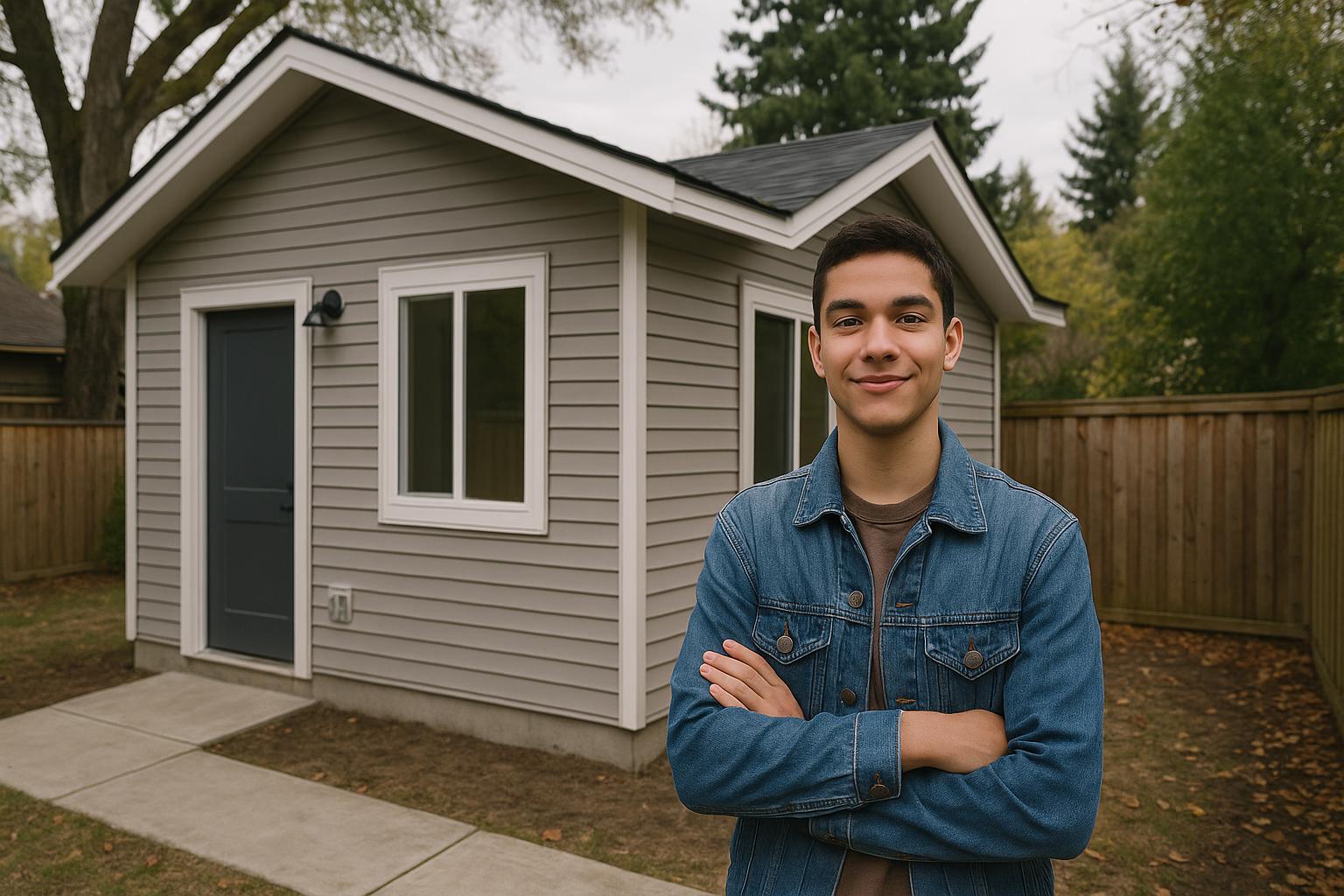
Transitional Housing and Affordable ADUs: Canadian Solutions for Youth Moving Toward Independent Living
Estimated reading time: 7 minutes
Key Takeaways
- Transitional Housing Impact: *Provides safe, temporary accommodation along with counselling, education, and life skills training for youth moving toward independence.*
- ADUs as Innovative Solutions: *Affordable Accessory Dwelling Units offer practical, cost-efficient housing options that fit within existing neighbourhoods.*
- Collaborative Success: *Partnerships among municipalities, non-profits, developers, and community organizations are key to delivering effective transitional housing.*
- Regulatory Navigation: *Understanding zoning, permitting, and safety codes is crucial to successfully integrating ADUs into transitional housing programs.*
- Proven Results: *Real-world examples like Wellington-Guelph demonstrate dramatic drops in youth homelessness when these models are implemented.*
Table of Contents
- Introduction: Transitional Housing for Youth and the Promise of Affordable ADUs
- Understanding Transitional Housing for Youth: Challenges and Support Systems
- What Are Affordable ADUs? Understanding Canadian Solutions
- The Role of ADUs in Canadian Transitional Housing Solutions
- Partnership Models: Youth Transitional Housing and Affordable ADUs
- Regulatory Considerations: Canadian Solutions for Safe Transitional Housing
- Success Stories: Independent Living for Youth Through Affordable ADUs
- Conclusion: The Promise of Transitional Housing and Affordable ADUs in Canada
- Call to Action: Get Involved in Canadian Solutions for Transitional Housing
- Frequently Asked Questions
Introduction: Transitional Housing for Youth and the Promise of Affordable ADUs
Transitional housing is transforming the future for Canadian youth. Facing hurdles from unstable family environments or homelessness, many young people benefit from the secure framework that transitional housing provides. It not only offers shelter but also counselling, education support, and essential life skills training. This support system bridges the gap between crisis and independent living. As highlighted in recent studies, transitional housing is a lifeline for youth moving from difficult circumstances towards long-term stability. Learn more from this research and further insights can be found on PubMed.
At the forefront of innovative housing options, Accessory Dwelling Units (ADUs) such as basement apartments, laneway houses, and garden suites are emerging as affordable solutions. Canadian cities are embracing these flexible units, which allow smart use of existing neighbourhoods while addressing the growing demand for transitional housing. Discover more about this trend on ADU Start.
Understanding Transitional Housing for Youth: Challenges and Support Systems
Canadian youth, between the ages of 13 and 24, encounter unique challenges such as:
- Higher risk of homelessness: Youth, especially those from marginalized communities, face heightened vulnerabilities. Studies show that Indigenous, 2SLGBTQI+, and foster care youth are overrepresented in shelters (source, source).
- Limited income: Many young people earn minimum wage or less, impacting their ability to secure stable housing.
- Lack of rental history: Without a robust rental record, accessing safe housing is much harder.
- Discrimination and trauma: Factors such as racism, homophobia, and experiences of trauma add further barriers.
- Family instability: Domestic conflict or crisis often leaves youth searching for immediate, safe shelter.
Transitional housing provides a structured environment offering temporary accommodation, case management, counselling, education, and job support — all of which are critical in steering youth towards independence (Homeless Hub).
What Are Affordable ADUs? Understanding Canadian Solutions
Affordable ADUs, or Accessory Dwelling Units, are small, self-contained living spaces that are built on the same lot as an existing home. They may include basement suites, laneway houses, or backyard cottages, each designed to be completely independent with their own kitchen, bathroom, and living area.
- Cost-effective building: ADUs lower the construction and land costs by repurposing existing infrastructure.
- Compact size: Their limited footprint reduces material and utility expenses.
- Smart density: They optimize underused spaces in residential areas, making community integration smoother.
These benefits, along with the flexibility to customize design for accessibility or privacy, have led Canadian cities to adopt ADUs as part of broader transitional housing strategies. For more details on accessible design, visit ADU Start’s guide.
The Role of ADUs in Canadian Transitional Housing Solutions
The integration of ADUs in transitional housing strategies is evident across several Canadian cities:
- Municipal success stories: Cities like Toronto, Vancouver, and Edmonton have relaxed zoning rules, enabling homeowners to build additional secondary suites or laneway homes (Ontario ADU Zoning Guide).
- Flexible options in various neighbourhoods: Pilots of modular and garden suites show promising results in both urban and suburban contexts (Modular Homes Cost-Efficiency).
Innovative planning and policy adaptations — including streamlined approvals and incentives for non-profit organizations — are crucial to the success of ADU-based transitional housing models. This collaborative approach allows communities to not only provide shelter, but also comprehensive support for youth.
Partnership Models: Youth Transitional Housing and Affordable ADUs
For ADU-based transitional housing to be effective, strong partnerships are essential. The key roles include:
- Municipalities: They offer incentives, relax zoning restrictions, and provide public land to build ADUs. See more details on ADU Permitting in Ontario.
- Non-profit organizations: Entities like Wyndham House and A Way Home manage these housing units with expertise in case management and youth support (CAEH Success Stories).
- Developers and Builders: These professionals adapt and construct ADUs, ensuring they meet design standards and the unique needs of youth.
- Community Organizations: They complement housing with supportive services such as mental health counselling, job training, and educational support.
Such integrated partnerships lead to increased funding opportunities, streamlined implementation, and ultimately, more stable housing outcomes for youth.
Regulatory Considerations: Canadian Solutions for Safe Transitional Housing
Building ADU-based transitional housing requires adherence to local regulations:
- Zoning and Permitting: Each municipality enforces its own building codes and zoning bylaws. Recent reforms have simplified permitting for secondary suites and garden units (British Columbia ADU Permitting Guide).
- Safety and Accessibility: ADUs must comply with fire safety, accessibility, and occupancy rules (Tiny Home Fire Safety Canada).
- Community Concerns: Local opposition such as worries over parking or changes in neighbourhood character must be addressed through early engagement with planning offices.
Early consultation with municipal planning departments, pilot projects, and advocacy for youth-inclusive policies are recommended to navigate these challenges successfully.
Success Stories: Independent Living for Youth Through Affordable ADUs
Real-world success stories demonstrate the power of integrating ADUs into transitional housing:
- Wellington-Guelph Project: A remarkable 80% reduction in chronic youth homelessness was achieved through a coordinated approach combining government support, community partnerships, and tailored ADU designs (Read the detailed report).
- Urban Initiatives: In cities like Vancouver and Toronto, pilot programs placing vulnerable youth in laneway houses and secondary suites have led to improved mental health outcomes, education engagement, and sustainable living arrangements. Research from PubMed supports these findings.
The combination of stable shelter, on-site support, and community integration has proven effective in setting youth on a path toward long-term independence.
Conclusion: The Promise of Transitional Housing and Affordable ADUs in Canada
Transitional housing is a critical step in empowering youth to overcome hardships and build independent futures. Affordable ADUs are emerging as a versatile solution, leveraging existing land and infrastructure to create supportive environments tailored for youth.
- Adaptability and Affordability: ADUs offer a cost-effective, space-efficient alternative that can be quickly adapted to meet the changing needs of communities (Smart Urban Housing).
- Successful Collaboration: Effective partnerships among municipalities, non-profits, developers, and community groups unlock essential funding and ensure sustainable support systems (ADU Financing Guide).
- Regulatory Evolution: Ongoing efforts to streamline zoning and safety regulations will further enhance access to transitional housing for youth.
If scaled more widely, these Canadian solutions can dramatically reduce youth homelessness and nurture a generation equipped with the skills, confidence, and resilience to thrive independently.
Call to Action: Get Involved in Canadian Solutions for Transitional Housing
You can play an active role in helping young Canadians move towards independent living:
- Educate Yourself: Explore local ADU projects and housing policies on resources like ADU-Friendly Neighbourhoods.
- Engage with Community Organizations: Volunteer or donate to groups focused on youth transitional housing, and join advocacy efforts (learn more here).
- Contact Local Leaders: Reach out to municipal representatives to support policies that expand access to affordable ADUs and transitional housing.
Your involvement makes a real difference in creating healthier, more inclusive communities.
Frequently Asked Questions
What is transitional housing?
Transitional housing provides short-term accommodation along with essential support services like counselling, education, and job training to help youth move from high-risk or unstable situations to independent living.
How do ADUs support transitional housing needs?
ADUs offer affordable, self-contained living units that make efficient use of existing properties. Their customizable design and lower construction costs make them ideal for integrating supportive services and creating stable living environments for youth.
What role do partnerships play in these housing solutions?
Successful transitional housing relies on collaboration between municipalities, non-profit organizations, developers, and community groups. These partnerships streamline funding, regulatory approvals, and the integration of essential support services, ensuring more effective and comprehensive care for youth.
How can I find out more or get involved?
You can visit local government websites, non-profit organizations’ pages, and resources like ADU Permitting Guides to learn more. Getting involved by volunteering or advocating for youth housing policies is also highly encouraged.

Leave a Reply